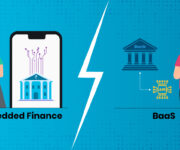Embedded finance is technically a package deal.
It combines a non-financial consumer experience with a suitable and usually complementary financial product or service. All in all, this combination aims to provide a superior customer experience. By 2027, global embedded finance market revenues are expected to exceed $183 billion.
Embedded finance brings three advantages in one go. First, it renders convenience to the consumer, opens new service delivery channels for the financial service providers, and finally, creates new revenue opportunities for the non-financial companies, serving as touch points.
Aside from the apparent benefits, embedded finance offers excellent opportunities to collect actionable customer data by making reporting, data collection, processing, and analysis easier for participants.
In this blog, we will discuss how fintech companies, banks and incumbent lenders can use customer spending data to stake their claims in the emerging market.
Vital Aspects of Customer Spending Data
Edge against competitors
A consumer’s spending data sheds light on his financial and behavioural priorities. When employed correctly, this information can be leveraged for fighting competition.
Studies have shown that companies that use consumer behavioural data for strategic decisions outperform their competitors by 85% in sales growth and by more than 25% in gross margin.
Overview of Granular Details
Consumer spending data tracks when, where, how much, and what a person or business entity spends money on.
It also encapsulates other details like how frequently they purchase things and whether or not they repurchase the same products or revisit the same seller. Such information has a critical bearing on product engagement strategies and marketing initiatives.
Basic customer expenditure data inherently records the following details:
- Purchase amount/ money spent
- Transaction date and time
- Merchant name or ID
- Payment method- credit purchase, prepaid or cash-on-delivery, EMI, etc.
- Transaction currency and exchange rate
- Details of customer loyalty programs, promo codes used, and coupons redeemed
What kind of personal details are included in spending data?
Based on what the platform/ site records, the spending data may also include the consumer’s personal details like name, mobile phone number, email id, age, gender, etc.
However, individuals voluntarily provide these details and are not captured automatically by the program.
Users must typically log into the Application Programming Interface (API) to access financing solutions via embedded finance.
How is Customer Spending Data Gathered?
Every time a transaction is made, a record of that transaction is generated. This record will contain all the above details regarding the purchase.
Spending information is also obtained using debit and credit card transaction details, details of ACH (Automated Clearing House) payments, Point Of Sales (POS) data (at the physical check-out counters), digital receipts, etc.
For e-commerce transactions, log-in and check-out processes are sources of customer spending data. Loyalty program codes, rewards, and promo codes also capture relevant customer data. Website cookies are another important data collection tool.
In most instances, the data collection is frequently erratic and delayed. Embedded finance technologies, on the other hand, provide businesses with real-time, raw data that algorithms can parse and use to detect behavioural patterns.
How can Banks and Lenders Leverage the Spending Data?
The spending data is used to observe, identify and predict consumer behaviour. This information aids in the customisation of product design, service delivery, and consumer engagement initiatives.
Here are some ways in which banks and lenders utilise spending data:
- Marketing analysis
Customers’ spending habits accurately measure the success of your customer loyalty programmes and advertising campaigns. If buyers consistently choose a competitor despite your enticing exclusive customer retention programmes, you should reconsider your strategy and revamp the schemes.
- Financial product development
Banks, fintech lenders, and non-financial enablers who own the embedded access points can use inputs from spending data analysis to develop new products and strengthening their product offerings.
- Offer recommendations to customers
Machine learning algorithms can detect patterns in financial data and predict when the consumer will be paid, what products they will purchase, whether there will be any recurring payments such as bills or subscriptions, and so on. These programs can generate personalised product recommendations based on customer behaviour data.
- Identify risky leads
This use case is particularly relevant to embedded lenders. Financial institutions use spending data to understand individual spending patterns, payment preferences, credit card usage frequency, and so on. Machine learning can identify non-linear relationships in transactional data, common to credit risks. As a result, lenders better understand their customers’ repayment behaviour and achieve greater control over risky lending.
- Personalise customer service
Spending data allows a more in-depth understanding of a consumer’s needs and purchasing habits. Sellers can use this data to personalise discount offers, promotional campaigns, and customer engagement programmes to provide superior customer service to their clients.
- Deepening customer relationships
An individual’s financial services requirements are linked to the lifecycle stages. Customers make major financial decisions corresponding to life events such as marriage, house purchase, retirement, etc. Banks can use data and other indicators to predict significant life events and connect with customers at the right time, and such positive experiences will increase customer loyalty.
Embedded Finance: The Future Outlook
Embedded finance is currently dominating the fintech segment at the moment. The service model is integrated into the financial ecosystem, and the market is gearing up for more competition. Embedded finance is becoming increasingly popular in the areas of payments, lending, card issuance, and deposits. In the future, we will see an increase in collaboration between incumbent financial institutions and fintech in the field of embedded finance.
Read how partnering with fintechs helps banks unlock sustainable growth.
The hordes of transactional and non-transactional data generated through embedded finance partnerships will give banks and lenders a competitive advantage.
However, data is not the only differentiator. Robust analytics aids in correctly reading data and providing accurate insights, and faulty analysis may generate unfavourable outcomes. As renowned British economist and Nobel laureate Ronald H Coase aptly articulated, “if you torture data long enough, it will confess to anything”.
Using Finezza’s Comprehensive Analytics Suite, you can avoid flawed analytics during lending decisions. Our analytics suite employs Machine Learning and Big Data Analytics to incorporate organisational learning. Users of Finezza can also create customised reports that they can access via our portal, real-time chatbots, or email.
Contact us today to learn more about our products.




Leave a Reply